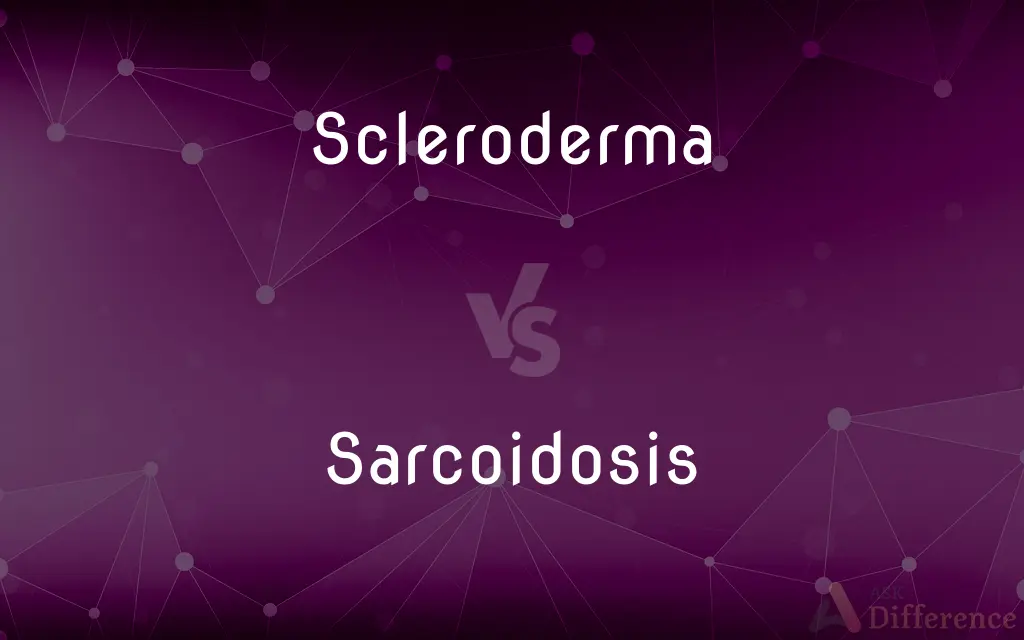Scleroderma vs. Sarcoidosis — What's the Difference?
Edited by Tayyaba Rehman — By Maham Liaqat — Updated on March 26, 2024
Scleroderma involves skin thickening and tightening, while sarcoidosis is characterized by immune system attacks on organs.

Difference Between Scleroderma and Sarcoidosis
Table of Contents
ADVERTISEMENT
Key Differences
Scleroderma primarily affects the skin, leading to hardening and tightening, which can severely impact mobility and organ function. Sarcoidosis, on the other hand, involves the immune system forming abnormal masses or nodules (granulomas) in various organs, leading to inflammation and impaired organ function.
While scleroderma can cause systemic issues affecting internal organs like the lungs, heart, and kidneys, its hallmark is skin changes. Sarcoidosis, whereas, primarily affects the lungs and lymph nodes but can also impact the eyes, skin, heart, and nervous system, without necessarily causing skin hardening.
Scleroderma's progression and symptoms vary significantly among patients, with some experiencing only mild skin issues, while others face life-threatening complications. On the other hand, sarcoidosis often presents with more uniform symptoms such as fatigue, weight loss, and fever, with the severity depending on the extent of organ involvement.
Diagnosis of scleroderma often involves identifying specific antibodies in the blood, skin biopsies, and organ function tests. Sarcoidosis diagnosis, however, relies on a combination of imaging tests, such as chest X-rays and CT scans, biopsies, and sometimes PET scans to identify granulomas and assess organ involvement.
Treatment for scleroderma focuses on managing symptoms and preventing complications, utilizing medications like immunosuppressants and physical therapy. Sarcoidosis treatment may not always be necessary if symptoms are mild, but severe cases might require corticosteroids or other drugs to reduce inflammation and prevent organ damage.
ADVERTISEMENT
Comparison Chart
Primary Affected Areas
Skin, potentially internal organs
Lungs, lymph nodes, eyes, skin, and other organs
Symptoms
Skin thickening, hardening, organ dysfunction
Fatigue, weight loss, fever, granulomas
Diagnosis
Blood tests for antibodies, skin biopsy, organ function tests
Imaging (X-ray, CT), biopsies, PET scans
Treatment
Symptom management, immunosuppressants, physical therapy
Possibly none, or corticosteroids for inflammation
Prognosis
Varies widely; can be life-threatening
Often good with treatment; can become chronic
Compare with Definitions
Scleroderma
Autoimmune Disease
Scleroderma causes the body to produce excess collagen, leading to skin thickening.
Sarcoidosis
Inflammatory Disease
Sarcoidosis leads to the formation of granulomas in various organs, affecting their function.
Scleroderma
Systemic Impact
Scleroderma can affect internal organs, such as the lungs and heart, causing serious complications.
Sarcoidosis
Symptoms
Common symptoms include cough, fatigue, and shortness of breath.
Scleroderma
Treatment
Treatment focuses on managing symptoms and may include immunosuppressants.
Sarcoidosis
Treatment
Treatment may involve observation or medications like corticosteroids to reduce inflammation.
Scleroderma
Diagnosis
Diagnosis is based on symptoms, blood tests for specific antibodies, and biopsies.
Sarcoidosis
Diagnosis
Diagnosis includes imaging tests, such as X-rays and CT scans, and biopsies to identify granulomas.
Scleroderma
Symptoms
Patients may experience stiff, swollen fingers and thickened skin patches.
Sarcoidosis
Organ Involvement
While primarily affecting the lungs, sarcoidosis can also impact the eyes, skin, and heart.
Scleroderma
A pathological thickening and hardening of the skin.
Sarcoidosis
Sarcoidosis (also known as Besnier-Boeck-Schaumann disease) is a disease involving abnormal collections of inflammatory cells that form lumps known as granulomata. The disease usually begins in the lungs, skin, or lymph nodes.
Scleroderma
(medicine) A chronic systemic autoimmune disease characterized by hardening the skin or other organs through excessive deposits of collagen.
Sarcoidosis
A disease of unknown origin that is characterized by the formation of granulomatous lesions especially in the lungs and lymph nodes of the chest and trunk, and less often in the skin, eyes, and other organs, and that if untreated may lead to chronic illness and organ damage. Also called sarcoid.
Scleroderma
A disease of adults, characterized by a diffuse rigidity and hardness of the skin.
Sarcoidosis
(medicine) A multisystem disorder characterized by granulomas.
Scleroderma
Genus of poisonous fungi having hard-skinned fruiting bodies: false truffles
Sarcoidosis
A chronic disease of unknown cause marked by the formation of nodules in the lungs and liver and lymph glands and salivary glands
Common Curiosities
Are scleroderma and sarcoidosis treatable?
Both conditions are manageable with treatments focusing on symptom management and preventing complications.
How do scleroderma and sarcoidosis primarily differ?
Scleroderma mainly affects the skin and potentially internal organs, while sarcoidosis forms granulomas in the lungs and other organs.
Can scleroderma and sarcoidosis both affect the lungs?
Yes, both conditions can affect the lungs, but sarcoidosis primarily does so, whereas scleroderma can as part of systemic involvement.
What is sarcoidosis?
Sarcoidosis is an inflammatory disease where the immune system forms granulomas in various organs, leading to dysfunction.
What is scleroderma?
Scleroderma is an autoimmune disease causing skin thickening and hardening, potentially affecting internal organs.
Is there a cure for scleroderma or sarcoidosis?
There is no cure for either condition, but symptoms and complications can be managed with treatment.
Who is at risk for developing scleroderma?
Risk factors include genetic predisposition and certain environmental exposures, with women more commonly affected.
What is the prognosis for someone with scleroderma?
The prognosis varies widely depending on the organs involved and the severity of the condition.
What are the long-term effects of scleroderma?
Long-term effects can include significant organ damage and mobility issues due to skin thickening.
Can lifestyle changes help manage scleroderma or sarcoidosis?
While not curative, certain lifestyle changes can help manage symptoms and improve quality of life.
Who is at risk for developing sarcoidosis?
While the exact cause is unknown, risk factors may include genetics and exposure to certain environmental agents.
Can sarcoidosis go away on its own?
Some cases of sarcoidosis may resolve without treatment, but others require medication.
What is the prognosis for someone with sarcoidosis?
With treatment, the prognosis is often good, though the condition can become chronic or lead to complications in some cases.
What are the long-term effects of sarcoidosis?
Long-term effects may include chronic lung problems and other organ dysfunction if not adequately treated.
Share Your Discovery

Previous Comparison
Mad vs. Sad
Next Comparison
Clearstory vs. ClerestoryAuthor Spotlight
Written by
Maham LiaqatEdited by
Tayyaba RehmanTayyaba Rehman is a distinguished writer, currently serving as a primary contributor to askdifference.com. As a researcher in semantics and etymology, Tayyaba's passion for the complexity of languages and their distinctions has found a perfect home on the platform. Tayyaba delves into the intricacies of language, distinguishing between commonly confused words and phrases, thereby providing clarity for readers worldwide.













































